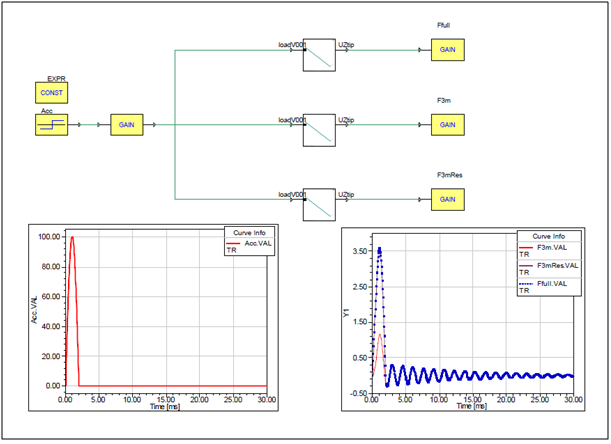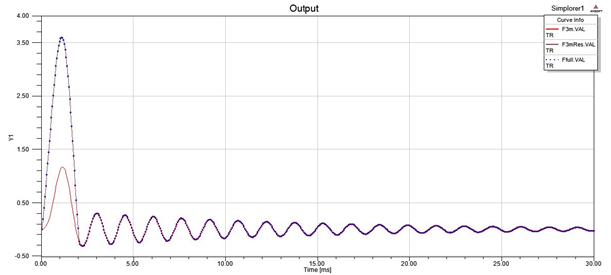The SPMWRITE command can be used to export state-space matrices based on a modal analysis when:
The damping is proportional (no element damping).
The mass and stiffness matrices are symmetric.
Prior to calculating the state-space matrices, you need to perform a modal analysis using the LANB, LANPCG, SNODE, or SUBSP eigensolver (MODOPT command). When obtaining the modal solution, consider the following:
Modes do not need to be expanded.
If you are applying nodal loads (forces or torques), you may specify them directly through table parameter input (inputs on the SPMWRITE command). For other types of loads (e.g. pressure) you must define the loads in the modal analysis and use the MODCONT command to generate the corresponding load vectors.
If you need an initial condition for your reduced model, you must define the load in the modal analysis to generate the corresponding load vector (NIC on the SPMWRITE command).
Damping must be specified (see DMPRAT, MDAMP, BETAD, or ALPHAD command).
State-space matrices are calculated in postprocessing using the file Jobname.mode. They are written to the file Jobname.spm using the requested format (FileFormat on the SPMWRITE command).
10.1.1. Examples of SPMWRITE Command Usage
This section describes how to use SPMWRITE to export state-space matrices based on two sets of model criteria.
The first set of model criteria for export to Twin Builder are as follows:
10 modes are taken into account.
There are 2 inputs specified in the array parameter ‘inputTab’.
The inputs labels are defined in the character array parameter ‘inputLab’.
There is 1 output specified in the array parameter ‘outputTab’.
The output label is defined in the character array parameter ‘outputLab’.
The initial condition is calculated from the first load vector.
Velocity and acceleration results are not included.
The SML format for Twin Builder is used to print out the state-space matrices.
If your model can be described by this first set of criteria, issue the following to export the state-space matrices:
! ** inputs definition *dim,inputTab,,2,2 *dim,inputLab,CHAR,2 inputTab(1,1) = 413 ! node 413 inputTab(1,2) = 1 ! ux inputLab(1) = ‘n413_ux’ inputTab(2,1) = node(50e-2,0,45e-2) ! node @(.5,0,.45) inputTab(2,2) = 4 ! rotx inputLab(2) = ‘n01_rotx’ ! ** outputs definition *dim,outputTab,,1,2 *dim,outputLab,CHAR,1 outputTab(1,1) = 1022 ! node 1022 outputTab(1,2) = 1 ! ux outputLab(1) = ‘n1022_ux’ spmwrite,modal,10,inputTab,inputLab,outputTab,outputLab,1
The second set of model criteria are as follows:
All modes are taken into account.
The inputs are based on all existing load vectors from the modal analysis.
The outputs are equal to the inputs.
There is no initial condition.
Velocity and acceleration results are not included.
The dense format is used to printout the state-space matrices.
If your model can be described by this second set of criteria, issue the following to export the state-space matrices:
spmwrite,modal, ,, ,, ,, ,0
The model in this example is a basic representation of a disk drive suspension as described in Hatch[1]. It is a clamped-free beam with a mass and spring at tip. The mass represents the recording head. The reduced model is generated in Ansys and imported into Twin Builder where global half-sine acceleration is applied in a transient analysis.
- Material
Young Modulus: 190e+6 mN/mm2
Density: 7.83e-6 kg/mm3
Poisson ratio: 0.293
- Beam
Length: 20 mm
Area: 0.15 mm2
Cross section inertia IYY: 0.05 mm4
Cross Section inertia IZZ: 0.00007031 mm4
- Spring
Stiffness: 1.e+7 N/mm
- Mass at tip
Mass: 1.e-6 kg
Use the input below to generate the state-space matrices file (file.spm) based on the first 3 modes plus the residual vector.
/title, Beam on Shaker (ACEL) - SPMWRITE 3 modes + resvec /prep7 ! ** Parameters num_elem = 16 nummodes = 2*num_elem ! ** Material ex,1,190e6 dens,1,7.83e-6 nuxy,1,0.293 ! ** Properties r,1,0.15,0.05,0.00007031,0.075,0.2 r,2,1000000 r,3,0.00002349,0.00002349,0.00002349 ! Nodes n,1,0,0,0 n,num_elem+1,20,0,0 fill,1,num_elem+1 n,num_elem+2,20,0,-3 nall ! ** Beam et,1,4 type,1 mat,1 real,1 e,1,2 egen,num_elem,1,-1 ! ** Spring et,2,14 type,2 real,2 e,num_elem+1,num_elem+2 ! ** Mass et,3,21 type,3 real,3 e,num_elem+1 ! ** Constraints d,1,all,0 d,num_elem+2,all,0 nsel,s,node,,2,num_elem+1 d,all,ux d,all,uy d,all,rotx d,all,rotz nsel,all fini ! ** Modal analysis /solu antype,modal modopt,lanb,3 ! << 3 modes mxpand,3 resvec,on ! << residual vector acel,,,1.0 ! << load vector definition dmprat,0.02 ! << modal damping solve fini /post1 /eshape,1 ! ** Definition of the output *dim,output,,1,2 output(1,1) = num_elem+1 ! << node at tip output(1,2) = 3 ! << UZ *dim,outputLab,CHAR,1 outputLab(1) = 'UZtip' ! ** Write SPM file: input = load vector spmwrite, modal, ,,, output, outputLab *list,,spm fini
The state-space matrices file can be imported in Twin Builder using: Twin Builder Circuit > SubCircuit > Add Mechanical Component
A transient analysis is performed in Twin Builder for the 3 following reduced models:
All 32 modes are used.
First 3 modes are used.
First 3 modes plus residual vector are used (Ansys input is listed above).
The schematic of the simulation is shown on the figure below:
A zoom on the graph showing the evolution of the spring force is given below:
The reduced model based on the first 3 modes (red curve) is not accurate. When the residual vector is included (purple curve), the spring force is similar to the reference given by the 32 modes reduced model (dotted curve).




